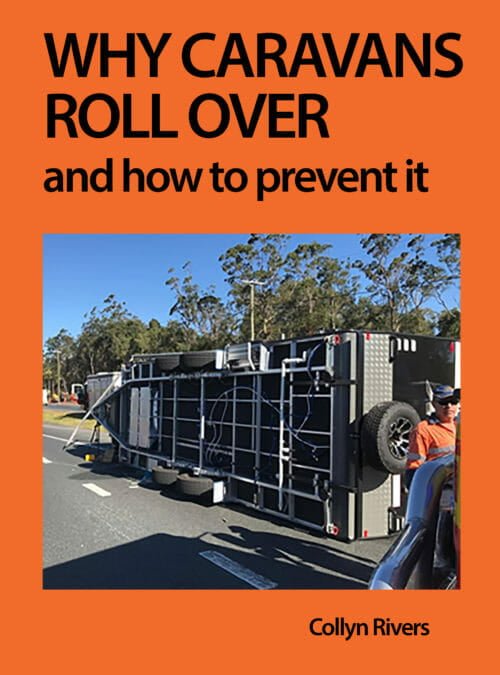by Collyn Rivers
Why travel trailers sway and roll over
Travel trailers towed by an overhung hitch sway and may overturn. This article explains why travel trailers sway and roll over – and how to prevent it.
![Why [cara_s] sway and roll over - how to prevent it 1 travel trailers sway](https://rvbooks.com.au/wp-content/uploads/2020/04/SwayImage.jpg)
Why travel trailers sway and roll over – how to prevent it is that a tow vehicle and travel trailer interact like a double pendulum. The upper pendulum is the tow vehicle. The lower pendulum is the travel trailer. It pivots from the bob (that overhung hitch) of the upper pendulum.
If the tow vehicle sways clockwise, that overhung hitch causes the travel trailer to anti-clockwise. Likewise, if travel trailers sway clockwise the tow vehicle is caused to sway anticlockwise. If that sway escalates at speed, the rig may jack-knife and roll-over. The interaction’s severity has many factors. These include:
A laden travel trailer weighing more than a laden tow vehicle. An excess extension of the tow hitch from the tow vehicle’s rear axle. A tow vehicle that is too short (the longer and heavier, the better).
Inadequate tow ball weight is also why travel trailers sway and roll over
As with an arrow, moving objects need to be front-heavy. Short centre-heavy trailers need 6%-7% of their laden weight. Travel trailers really need 10%.
External forces trigger instability. Such forces include gusting side winds, wind gusts from overtaking or overtaken trucks. Furthermore, cornering too fast, sudden and major changes in road camber, veering off the side of the road or steering overcompensating – all-cause instability. Excess speed is always an issue.
Why travel trailers sway and roll over – how to prevent it is that any or all of the above can result in the tow vehicle being triggered into a highly unstable condition. Called over-steer, it’s rear tyres lose control. If that happens above a critical speed (unique to each rig and its loading) it results in rapidly escalating snaking that is not driver-controllable. Within a few seconds, that rig jack-knifes and often rolls over.
That rarely understood by RVers is that their rig may feel ultra-stable in normal driving. Further, most owners never encounter this situation. The issues, however, are escalating as travel trailers become bigger and heavier. Meanwhile, tow vehicles become lighter.
There are some frightening dash-cam videos available online showing the double pendulum effect in operation on towed travel trailers. See our Travel Trailer Rollover page.
Causal factors include the ratio of the tow vehicle to travel trailer weight, the length of hitch overhang, tow ball mass and excess speed. If you tow a travel trailer that is heavier than the tow vehicle you are at far greater risk than if not. This is particularly so when descending any steep gradient at speed. It is even more so if there are also bends or side winds.
The rig’s critical speed is also related to tow ball mass. The lower than mass the lower the critical speed.
Our book Why Caravans Roll Over – and how to prevent it is a plain English explanation of not just how and why. It explains what you can do to increase its margin of stability. It includes a section enabling you to assess your own rig’s probable stability. And how to fix defects.
Friction sway reducers (ineffective at speed)
Why Caravans Roll Over – and how to prevent it explains that while friction sway reducers work well at low to medium speed, all have a fundamental limitation. That limitation is that frictional damping is constant. The forces they attempt to dampen, however, increase with the square of the rig’s speed. Such sway reducers improve ride comfort but at 100 km/h have virtually zero effect. Independent tests have shown that that damping is then less than 1%.
Our book Why Caravans Roll Over – and how to prevent it, explains all. The major part of it is written in totally clear English. It also has a section that explains the issues in more technical detail. This part is primarily for engineers working in the travel trailer industry and technically-minded readers seeking detailed explanations. It includes many references.
In essence, Why Caravans Roll Over – and how to prevent it, explains just why travel trailers may jack-knife and roll over It shows to assess the stability of your own tow vehicle and travel trailer – and how to fix any issues.
The Caravan Council of Australia describes it as ‘compulsory reading’.




